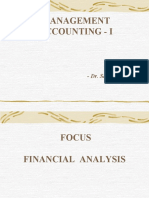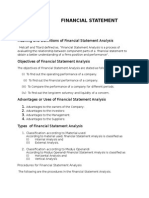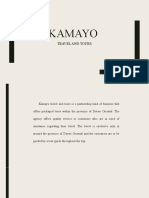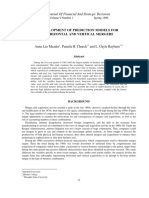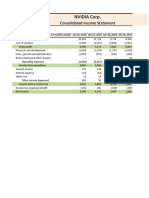0 ratings0% found this document useful (0 votes)
62 viewsFS Analysis-Ratios
This document discusses financial statement analysis and the various techniques used to analyze financial statements. It explains that financial statement analysis identifies the financial strengths and weaknesses of a firm by establishing relationships between balance sheet and income statement items. Various analytical techniques are described, including horizontal analysis, vertical analysis, trend analysis, common-size analysis, and ratio analysis. Key ratios are also defined that are used to analyze a firm's liquidity, asset efficiency, profitability, and financial leverage. The overall purpose of financial statement analysis is to evaluate a firm's performance and financial position over time and in comparison to benchmarks.
Uploaded by
Dayan Isuru PereraCopyright
© © All Rights Reserved
Available Formats
Download as PDF, TXT or read online on Scribd
0 ratings0% found this document useful (0 votes)
62 viewsFS Analysis-Ratios
This document discusses financial statement analysis and the various techniques used to analyze financial statements. It explains that financial statement analysis identifies the financial strengths and weaknesses of a firm by establishing relationships between balance sheet and income statement items. Various analytical techniques are described, including horizontal analysis, vertical analysis, trend analysis, common-size analysis, and ratio analysis. Key ratios are also defined that are used to analyze a firm's liquidity, asset efficiency, profitability, and financial leverage. The overall purpose of financial statement analysis is to evaluate a firm's performance and financial position over time and in comparison to benchmarks.
Uploaded by
Dayan Isuru PereraCopyright
© © All Rights Reserved
Available Formats
Download as PDF, TXT or read online on Scribd
You are on page 1/ 6
Financial Statements Analysis
MBA 539 Financial Reporting and Management
Control Systems
Master of Business Administration
Faculty of Management & Finance
University of Colombo
R.M.R.B.Rajapakse, Senior Lecturer in Accounting
Financial Statements..few ?s.
Do F/Ss produce comparative information?
Are these information enough to make
decisions?
Why? absolute figures do not produce
comparative information, less utility and
practical value
What further do? convert into relative /
comparative figures
Financial Analysis -what does it do?
Financial statement analysis is the process of
identifying the financial strengths and
weaknesses of the firm by properly
establishing relationship between the items of
balance sheet and the income statement
It enhance the utility or practical value of
accounting information.
Why Financial analysis is needed? Since,
It produces comparative information
Its a tool to identify strength and weaknesses
It provides information of profitability,
liquidity, efficiency and gearing/ solvency etc.
Further it Provides Answers to.
Is the firm in a position to meet current
obligation? -Liquidity
What sources of long-term finance are employed
and its relationship (debt-equity)?- Solvency
How efficiently assets utilised?- Assets turnover
Are earnings adequate?- Profitability
Do profitability and safe is satisfy? - Supportive
evidence
Produce Comparisons Information
Absolute increases and decreases for an item
from year to year
% increases and decreases for an item from
year to year
Trend %
% of single item to an aggregate total
Ratios
Compare with.
Past years ratios
Budgeted/ standards
Intra company - divisional
Inter company - industry
Analytical Techniques
Horizontal analysis
Vertical analysis
Trend analysis
Common-size analysis
Ratio analysis
Cash flow analysis
Horizontal Analysis
The calculation of $ (Rs. value) changes or %
changes in the statement or total
Ex; changes in sales, total operating expenses,
N.P.
It detects changes in company performance
It highlights trends
Horizontal Analysis
2012 2011 increase/ %
(decrease)
Revenue
Sales 207,500 159,500 48,000 30.1
Cost of sales 145,000 114,500 30,500 26.6
Gross profit 62,500 45,000 17,500 38.9
Operating Expenses
Selling & Distribution 19,750 13,650 6,100 44.7
Administrative 24,820 16,300 8,520 52.3
Total Operating Expenses 44,570 29.950 14,620 48.8
Profit from operations 17,930 15,050 2,880 19.1
Interest expenses 1,500 1,200 300 25.0
Profit before tax 16,430 13,850 2,580 18.6
Income tax 4,930 4,432 498 11.2
Profit after tax 11,500 9,418 2,082 22.1
Trend Analysis
Based on Horizontal analysis
% es are calculated for several successive
years
select a based year which assign a weight of
100%
Ex; base year sales is 100% current year 110%
OR 95% etc;
Trend Analysis
2008 2009 2010 2011 2012
Sales 100 85 119 158 205
Net profit 100 89 123 142 174
Vertical Analysis
Items in a single financial statement are
expressed as a % of a significant total.
Ex: cost of sales as % to turnover, G.P. as % to
cost of sales/ turnover
Vertical Analysis
2012 % 2011 %
Revenue
Sales 207,500 100.0 159,500 100.0
Cost of sales 145,000 69.9 114,500 71.8
Gross profit 62,500 30.1 45,000 28.2
Operating Expenses
Selling & Distribution 19,750 9.5 13,650 8.6
Administrative 24,820 12.0 16,300 10.2
Total Operating Expenses 44,570 21.5 29.950 18.8
Profit from operations 17,930 8.6 15,050 9.4
Interest expenses 1,500 0.7 1,200 0.7
Profit before tax 16,430 7.9 13,850 8.7
Income tax 4,930 2.4 4,432 2.8
Profit after tax 11,500 5.5 9,418 5.9
Common size Analysis
Common size financial statements show only
% value, no absolute value
In common-size balance sheet all values of
assets items are presented as a % to total
assets where as liability items are presented
as a% to total liabilities
Income statement- all items are presented as
a % to net sales
Common-Size Analysis
2012 2011
Revenue
Sales 100.0 100.0
Cost of sales 69.9 71.8
Gross profit 30.1 28.2
Operating Expenses
Selling & Distribution 9.5 8.6
Administrative 12.0 10.2
Total Operating Expenses 21.5 18.8
Profit from operations 8.6 9.4
Interest expenses 0.7 0.7
Profit before tax 7.9 8.7
Income tax 2.4 2.8
Profit after tax 5.5 5.9
Ratio analysis
Items of the financial statements are
presented as comparative figures as ratios
Classifications of ratios
Liquidity ratio - ability to meet current
obligation
Activity ratio - efficiency of assets utilisation
Profitability ratio - overall performance
Leverage ratio - proportion of debt equity
Liquidity ratio
Current ratio Current Assets/ Current liabilities
Quick ratio Current Assets- Stock/ Current
Liabilities
Working capital analysis
Current Assets- Current Liabilities
Activity/ efficiency ratio
Inventory turnover and stock holding
period
Debtors turnover and collection period
Fixed assets turnover
Total assets turnover
Capital employed turnover (long term capital
as value of capital employed): non- current
liabilities plus shareholders equity
Profitability ratio
Gross profit margin, Net profit margin
Return on investment (return on assets, return
on capital employed, return on shareholders
equity)
Earning per share, Dividend per share
Earning yield, Dividend yield
Price earning ratio
Earning power- combined effect of the net profit
margin and investment turn over
Leverage / Capital stricture ratios
Debt- equity ratio (long-term debt to equity, total
debt to equity, debt to total capital)
1. Long-term debt to equity-
Fixed interest or dividend bearing capital/ Equity capital
2. Total debt to equity- Fixed interest or dividend bearing capital+
Current liabilities/ Equity capital
3. Debt to total capital
Fixed interest or dividend bearing capital/ Total capital
Treatment of Preference Capital
If debt equity ratio is calculated to show the
effect of leverage on shareholders equity :
preference shares take as debt
If debt equity ratio is calculated to reflect
financial risk: preference shares take as equity
You might also like
- Assumptions - : Amazon Cashflow & Profit ForecastNo ratings yetAssumptions - : Amazon Cashflow & Profit Forecast22 pages
- Muhammad Luthfi Mahendra - 2001036085 - Tugas 5No ratings yetMuhammad Luthfi Mahendra - 2001036085 - Tugas 55 pages
- Management Accounting - I: - Dr. Sandeep Goel100% (1)Management Accounting - I: - Dr. Sandeep Goel109 pages
- Silva - Activity 3 Financial Statements AnalysisNo ratings yetSilva - Activity 3 Financial Statements Analysis3 pages
- Financial Statement Analysis - 2023 (Auto-Saved)No ratings yetFinancial Statement Analysis - 2023 (Auto-Saved)63 pages
- Understanding Financial Statements: Chris DroussiotisNo ratings yetUnderstanding Financial Statements: Chris Droussiotis23 pages
- Ten Year Reviews - Standalone and ConsolidatedNo ratings yetTen Year Reviews - Standalone and Consolidated1 page
- Meaning and Definitions of Financial Statement AnalysisNo ratings yetMeaning and Definitions of Financial Statement Analysis10 pages
- Financial Statements: BAO6504 Accounting For ManagementNo ratings yetFinancial Statements: BAO6504 Accounting For Management20 pages
- Financial (Rs Million) Mar-20 Mar-19 Mar-18 Mar-17 Mar-16 Y-O-Y Change (%) Y-O-Y Change (%)No ratings yetFinancial (Rs Million) Mar-20 Mar-19 Mar-18 Mar-17 Mar-16 Y-O-Y Change (%) Y-O-Y Change (%)1 page
- Amazon 4 Year Profit Cashflow Model - LLC VersionNo ratings yetAmazon 4 Year Profit Cashflow Model - LLC Version23 pages
- Financial modeling - open workshop 2Apr2022No ratings yetFinancial modeling - open workshop 2Apr202231 pages
- M004/CL02 Managerial Finance Coursework 1 Assignment Brief Guidelines and RubricNo ratings yetM004/CL02 Managerial Finance Coursework 1 Assignment Brief Guidelines and Rubric10 pages
- Interpretation of Financial Statements - Ratio Analysis100% (1)Interpretation of Financial Statements - Ratio Analysis10 pages
- IL - Gloom, Boom & Doom Report - March 2010No ratings yetIL - Gloom, Boom & Doom Report - March 20107 pages
- Development of Prediction Models For Horizontal and Vertical MergersNo ratings yetDevelopment of Prediction Models For Horizontal and Vertical Mergers13 pages
- Paper-8 Cost Accounting & Financial Mangement (Syllabus 2012) PDF100% (1)Paper-8 Cost Accounting & Financial Mangement (Syllabus 2012) PDF492 pages
- Analysing The Impact of Financial RatiosNo ratings yetAnalysing The Impact of Financial Ratios6 pages
- Accounting KFC Holdings Financial Ratio Analysis of Year 2009100% (6)Accounting KFC Holdings Financial Ratio Analysis of Year 200916 pages
- Measures of Leverage: by Dr. Muhammad AliNo ratings yetMeasures of Leverage: by Dr. Muhammad Ali29 pages
- Chapter 4. Financial Ratio Analyses and Their Implications To Management Learning ObjectivesNo ratings yetChapter 4. Financial Ratio Analyses and Their Implications To Management Learning Objectives29 pages
- Understanding Financial Statements: Chris DroussiotisUnderstanding Financial Statements: Chris Droussiotis
- Meaning and Definitions of Financial Statement AnalysisMeaning and Definitions of Financial Statement Analysis
- Financial Statements: BAO6504 Accounting For ManagementFinancial Statements: BAO6504 Accounting For Management
- Financial (Rs Million) Mar-20 Mar-19 Mar-18 Mar-17 Mar-16 Y-O-Y Change (%) Y-O-Y Change (%)Financial (Rs Million) Mar-20 Mar-19 Mar-18 Mar-17 Mar-16 Y-O-Y Change (%) Y-O-Y Change (%)
- M004/CL02 Managerial Finance Coursework 1 Assignment Brief Guidelines and RubricM004/CL02 Managerial Finance Coursework 1 Assignment Brief Guidelines and Rubric
- Interpretation of Financial Statements - Ratio AnalysisInterpretation of Financial Statements - Ratio Analysis
- Development of Prediction Models For Horizontal and Vertical MergersDevelopment of Prediction Models For Horizontal and Vertical Mergers
- Paper-8 Cost Accounting & Financial Mangement (Syllabus 2012) PDFPaper-8 Cost Accounting & Financial Mangement (Syllabus 2012) PDF
- Accounting KFC Holdings Financial Ratio Analysis of Year 2009Accounting KFC Holdings Financial Ratio Analysis of Year 2009
- Chapter 4. Financial Ratio Analyses and Their Implications To Management Learning ObjectivesChapter 4. Financial Ratio Analyses and Their Implications To Management Learning Objectives






